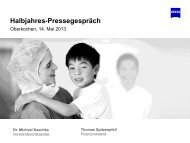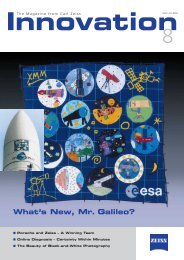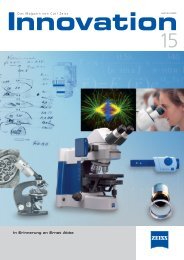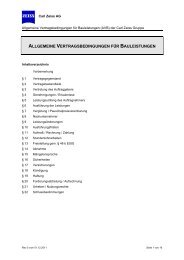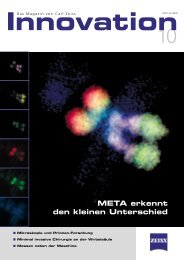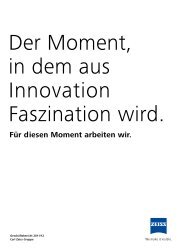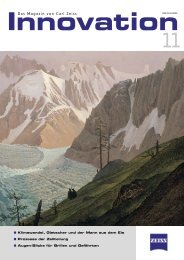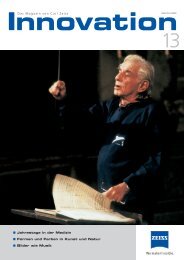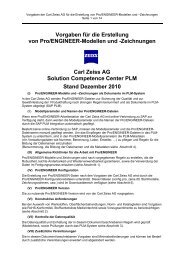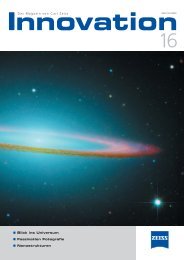Download PDF - Carl Zeiss
Download PDF - Carl Zeiss
Download PDF - Carl Zeiss
You also want an ePaper? Increase the reach of your titles
YUMPU automatically turns print PDFs into web optimized ePapers that Google loves.
Calcium fluoride or<br />
fluorite (CaF 2)<br />
Fluorite is a mineral of the halogenides<br />
class. It is not only a popular<br />
gem, but also an important raw material<br />
for the production of hydrofluoric<br />
acid, fluorine and fluxing agents<br />
(e.g. for the manufacture of aluminum)<br />
and for the etching of glass.<br />
Clear crystals are used as lens elements<br />
for optical instruments. Nowadays,<br />
artificially produced fluorite is<br />
used in optics. The name fluorite comes<br />
from the Latin word fluere (to<br />
flow) and resulted from the use of<br />
the mineral as a fluxing agent in the<br />
extraction of metals. Fluorite displays<br />
the colors purple, blue, green, yellow,<br />
colorless, brown, pink, black and reddish<br />
orange. At the end of the 19 th<br />
century Ernst Abbe was the first person<br />
to use natural fluorite crystals in<br />
the construction of microscope objective<br />
lenses in order to enhance<br />
chromatic correction.<br />
Oltscheren mountain<br />
pasture (1623 m)<br />
Hut no. 86 with the inscription “B<br />
1873 H*: edifice on a solid foundation,<br />
with a kitchen-cum-living room<br />
since 1996; saddle roof with …,<br />
three-room living area facing NE on<br />
the first floor (two rooms in the<br />
front, behind them a now unused<br />
kitchen and behind this a store and<br />
barn. Beside these a milking installation<br />
with 5 stands. The hut belonged<br />
to the <strong>Zeiss</strong> Works in Jena during<br />
the period when the company was<br />
mining for fluorite.<br />
Innovation 15, <strong>Carl</strong> <strong>Zeiss</strong> AG, 2005<br />
10<br />
Fig. 10:<br />
The Alpine house in Bielen<br />
(Bühlen) on the Oltscheren<br />
Alps in 1889. Ernst Abbe can<br />
be easily recognized in the<br />
enlarged section produced<br />
by Trinkler in 1930 using the<br />
best <strong>Carl</strong> <strong>Zeiss</strong> copying<br />
lenses available at that time.<br />
11



